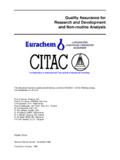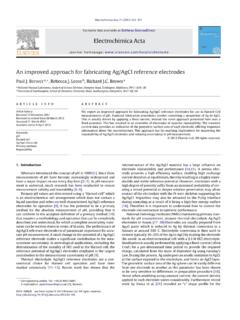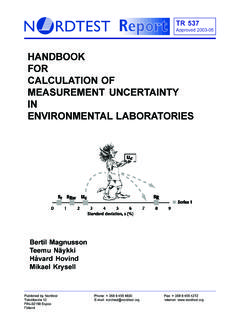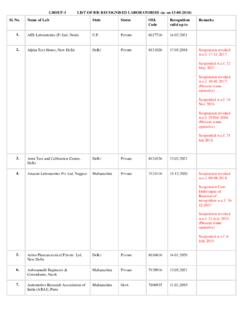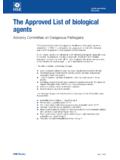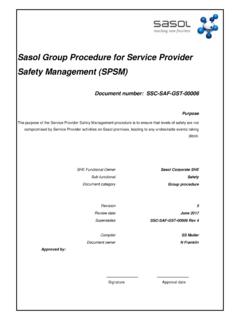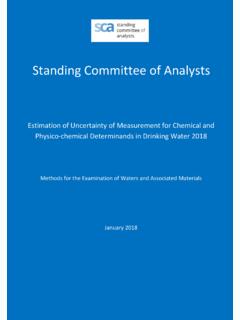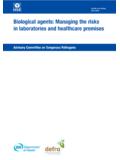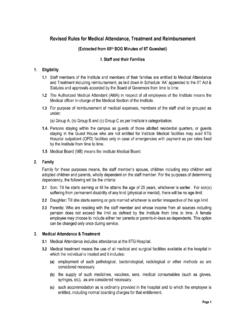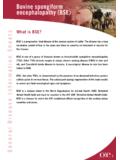Transcription of Guide to Quality in Analytical Chemistry - CITAC
1 Guide TO Quality IN Analytical Chemistry CITAC /Eurachem GuideEdition 20021 CITAC / EURACHEM Guide Guide to Quality inAnalytical ChemistryAn Aid to AccreditationPrepared jointly byCITAC (The Cooperation on International Traceability in Analytical Chemistry )and EURACHEM (A Focus for Analytical Chemistry in Europe) Guide TO Quality IN Analytical Chemistry CITAC /Eurachem GuideEdition 20022 Guide to Quality inAnalytical ChemistryAn Aid to AccreditationThis document has been produced by a joint Working Group of CITAC andEURACHEM and is based on earlier documents, including CITAC Guide 1,published in 1995 and the EURACHEM WELAC Guide published in edition deals with the new requirements of the standard ISO/IEC 17025:1999 - "General Requirements for the Competence of Testing and CalibrationLaboratories".
2 Guide TO Quality IN Analytical Chemistry CITAC /Eurachem GuideEdition 20023 Guide to Quality in AnalyticalChemistryAn Aid to AccreditationPublished 2002 Copyright of this Guide is the property of theorganisations represented on CITAC and edition has been published by CITAC and EurachemGUIDE TO Quality IN Analytical Chemistry CITAC /Eurachem GuideEdition 20024 Guide TO Quality IN Analytical and and Analytical of the Analytical Sampling, sample handling and preparation 1612. / procedures for calibrations and materials control and proficiency testing and computer controlled audit and review40 References and BibliographyAcronymsAppendicesAQuality Audit - Areas of Particular Importance in a Chemical LaboratoryBCalibration Intervals and Performance ChecksCComparison Table ISO/IEC 17025:1999 vs ISO/IEC Guide 25:1990 (ILACG15.)
3 2001) Guide TO Quality IN Analytical Chemistry CITAC /Eurachem GuideEdition AND aim of this Guide is to provide laboratories with guidance on best practice for theanalytical operations they carry out. The guidance covers both qualitative andquantitative analysis carried out on a routine or non-routine basis. A separate guidecovers research and development work ( CITAC /EURACHEM Guide reference A1 onpage 43). guidance is intended to help those implementing Quality assurance in those working towards accreditation, certification, or other compliance withparticular Quality requirements, it will help explain what these requirements mean.
4 Theguidance will also be useful to those involved in the Quality assessment of analyticallaboratories against those Quality requirements. Cross-references to ISO/IEC 17025, ISO9000 and OECD Good Laboratory Practice (GLP) requirements are This document has been developed from the previous CITAC Guide 1 (which in turn wasbased on the EURACHEM/WELAC Guide ), and updated to take account of new materialand developments, particularly the new requirements of the standard, ISO/IEC This Guide has been produced by a working group comprising David Holcombe, LGC,UK; Bernard King, NARL, Australia; Alan Squirrell, NATA, Australia and Maire Walsh,State Laboratory, Ireland.
5 In addition, over the years leading to the drafting of this andearlier versions of the Guide , there has been extensive input from a large number ofindividuals and organisations, including. CITAC , EURACHEM, EA, ILAC, AOACI,IUPAC, CCQM, and others (Refer Acronyms list on page 48). Guide concentrates on the technical issues of Quality assurance (QA), with emphasison those areas where there is a particular interpretation required for chemical testing orrelated measurements. There are a number of additional aspects of QA where noguidance is given as these are fully addressed in other documents, such as ISO/IEC17025.
6 These include records; reports; Quality systems; subcontracting; complaints;supplier's requirements; contract review; confidentiality and data value of chemical measurements depends upon the level of confidence that can beplaced in the results. Increasingly, the chemical testing community is adopting QAprinciples which, whilst not actually guaranteeing the Quality of the data produced,increases the likelihood of it being soundly based and fit for its intended Appropriate QA can enable a laboratory to show that it has adequate facilities andequipment for carrying out chemical analysis and that the work was carried out bycompetent staff in a controlled manner, following a documented validated method.
7 QAshould focus on the key issues which determine Quality results, costs and timeliness andavoid diversion of energies into less important Good QA practice, including its formal recognition by accreditation, certification etc.,help to ensure that results are valid and fit for purpose. However, it is important for bothlaboratories and their customers to realise that QA cannot guarantee that 100% of theindividual results will be reliable. There are two reasons for this: Guide TO Quality IN Analytical Chemistry CITAC /Eurachem GuideEdition 200261. Mistakes/gross errors can occur, where, for example, the results for two samples aremixed-up.
8 In a well-run laboratory, the frequency of mistakes will be small, but Random and systematic errors also occur, leading to uncertainty in a measured probability of a result lying within the stated uncertainty range depends on thelevel of confidence employed, but again, even in a well ordered laboratory, deviantresults will occasionally occur and very occasionally the deviation will be business of QA is to manage the frequency of Quality failures. The greater the efforttaken, the smaller the number of Quality failures that can be expected. It is necessary tobalance the cost of QA against the benefit in reducing Quality failures to an acceptable(non-zero) principles of QA have been formalised in a number of published protocols orstandards.
9 Those most widely recognised and used in chemical testing fall into threegroups and are applied according to a laboratory's individual needs. The three groups 17025:1999: (Ref B1) This standard addresses the technical competenceof laboratories to carry out specific tests and calibrations and is used bylaboratory accreditation bodies world-wide as the core requirements for theaccreditation of laboratories ; 9001:2000: (Ref B2) and its national and international equivalents. Thisstandard relates primarily to Quality management, for facilities carrying outproduction, or providing services, including chemical analysis; Principles of Good Laboratory Practice (GLP): 1998 (Ref B3) and itsnational and sectorial equivalents.
10 These guidelines are concerned with theorganisational processes and conditions under which laboratory studies related tocertain regulatory work are carried addition, there are Total Quality Management (TQM) approaches to QA which placeemphasis on continuous improvement (the new ISO 9001:2000 gives more emphasishere). Central to this Guide is the contention that, at the technical level, good practice inanalytical QA is independent of the formal QA system laboratory may decide to design its own QA procedures or it may follow one of theestablished protocols.
